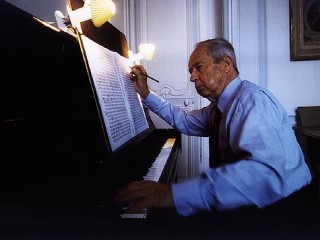
Marcel Landowski biography
Date of birth : 1915-02-18
Date of death : 1999-12-23
Birthplace : Pont-l'Abbé, Finistère, Brittany
Nationality : French
Category : Arts and Entertainment
Last modified : 2011-10-29
Credited as : lyric composer, ,
Marcel Landowski was a French composer of lyric works which emphasized a synthesis of music and text and reflected sensitivity to religious forces.
Marcel Landowski was born February 18, 1915. At age 11 he began to study harmony and piano privately with Marguerite Long. At the Paris conservatory he studied composition and conducting with Philippe Gaubert and Pierre Monteux. The premiere of his oratorio Rythmes du Monde (1939) attracted Honegger, whom Marcel Landowski still considers one of his masters. In 1939 he was drafted into the military service and fought in World War II. In July 1940 he was demobilized and received a military cross, after which he settled in the south of France, rejecting the invitation of Monteux to come and live in the United States. From 1946 to 1951 Landowski wrote articles for two musical reviews— Opera and Paris Comoedia. In 1960 he was appointed as director of the Boulogne Conservatory (near Paris), and in 1964 became the music director at the Ministry of Culture where he served until 1974. Within a few years he encouraged the study of music in France and formed a large number of orchestras—L'Orchestre de Paris, among others.
The compositions of Landowski, often inspired by religious subjects, remain, most of the time, within the tonal system. As he said: "True art is always an expression of faith." From his first works (1937) to his last compositions, Marcel Landowski reflected sensitivity to religious forces. He commented that "The mystery of artistic beauty must not be a quest in itself, we simply have to express, in the language which is given to us, what we feel and what we believe in. I do not believe in absolute music; nothing in life is separable, divisible and autonomous; everything, consciously or unconsciously, moves and converges towards a goal." Thus it is not surprising that he devoted himself to lyric works.
As early as 1939 Landowski completed a long oratorio to his own text: Rythmes du Monde for recitant, two soprano solos, mixed choir, and orchestra. In 1943 he linked poetry and music in Brumes, "poéme pour voix parlèe et orchestra," using poems of Verlaine and Patrice de la Tour du Pin. Drawn to Oriental poetry, he also composed 3 Reverences a la Mort for soprano and piano to poems of Rabindranath Tagore. Only after exploring very different lyric media did Landowski write an opera: Le Rire de Nils Halérius (1948). The work was not performed until 1951. Subtitled "Légende Lyrique et Chorèographique en Trois Actes," this piece recalls, in a free and personal way, the tradition of ballet in French opera of the 18th century. Some years previous Albert Roussel (1869-1937) had returned to the opera-ballet with Padmavathi, in which he included ballets as part of the action of the drama. From this time forward, Landowski wrote many operas, each concentrating on the dramatic expression obtained through the fusion of different operatic elements. His main interest concerned the relationship between music and drama. Thus he wrote: "Some parts of Boris, the second act of Tristan, the scenes between Don Giovanni and the Commendatore represent summits that will never be surpassed because music, dramatic expression and language are absolutely joined together to serve an idea or a myth."
This profession of faith appears in every lyric work of the composer from Le Fou (1956), his most successful opera; through Le Ventriloque (1957), a lyrical drama in one act, and L}es Adieux (1959), a lyrical comedy; to Montségur, whose successful premiere took place in February 1985 in Toulouse. In this opera, the story of a woman torn by the Cathare faith (similar to Albigensians) of her mother and the rigorous Catholicism of her father, Landowski again emphasized the drama through a synthesis of music and text. The latter work was given its first production by the Paris Opera in 1987.
His instrumental works, including the concerto for violoncello (1946); the concerto for ondes Martenot, strings, and percussion (1954); the concerto for bassoon and orchestra (1957); and the concerto for flute and strings, testify to his brilliant imagination within the framework of a relatively conservative tonal language. Landowski also wrote Les Notes de Nuit, symphonic tale with Narrator (1961), Un Enfant appelle, Concerto for Soprano, Cello, and Orchestra, after poems of Marie-Noel (1978). In addition to all this he also wrote some 89 film scores, spectacles with lights, piano pieces, and many scores for televison.
















